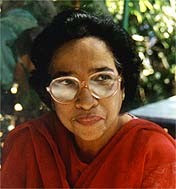Varmland in western Sweden is not on the usual tourist itinerary. Yet this is a beautiful region extending towards the Norwegian frontier. Driving through this quiet scenic countryside, its green rolling planes, its serene uplands and its placid lakes, makes a traveler feel one with nature. History records that Christianity spread from Norway to Sweden via Varmland.
The little town of Marbacka in this region was the home of Selma Lagerlof, a Swedish author. She was the first woman to receive the Nobel Prize for Literature.
Born on November 26th 1858 at Oster Emterwick, she grew up in Marbacka. Folklore, legends and traditions of this area became an inseparable part of her life. After her father’s illness, the family home had to be sold. Selma was loath to move away, and as soon as she could afford to, she bought it back and lived there till her death. In her book “The Story of the Manor” which was published in 1922, she describes this home at length.
Today Marbacka Manor belongs to a Foundation and is open to visitors in summer. As one wanders through those rooms and looks through her memorabilia, it is easy to visualize her life and times.
Selma was a teacher. She trained at the reputed Teachers’ Training College in Stockholm. She worked as a teacher for ten years. Though she started writing poetry at an early age, she did not get into print until 1890. Her novel Gosta Berlings Saga received wide acclaim especially after it was translated into Danish in 1891. It was the story of a clergyman who was dismissed from his job for his drunkenness.
This novel was followed by Osynliga Lanker (Invisible Links) in 1894. With her success, she decided to quit teaching and become a full time writer. It helped that the Royal family and the Swedish Academy offered to support her financially. She could also afford to travel extensively and visited Italy, Greece, Egypt and Palestine. She used some of these places as backdrops to her stories. Some were romantic; others were religious or touched on the supernatural. In Sicily, she saw a statue of Jesus which seemed more like a caricature of him. It prompted her to write “Miracles of the Antichrist” in 1897. One cannot ignore the blending of social and moral values in her writing.
In 1894, Selma became a friend of Sophie Elkan, another writer. They were fast friends till the end of her life. From their correspondence it was assumed that theirs was a homosexual relationship. Sophie showed signs of jealousy when Selma grew friendly with Valborg Ohlander, who was also her literary agent.
Selma’s knowledge of legends and folklore made her a good writer of children’s stories too. “The Wonderful World of Nils” became a children’s classic.
In 1900, Selma travelled to Jerusalem. This visit inspired her to write her major work “Jerusalem” in two volumes. It was a novel about Swedish peasants who migrated to the Holy Land.
By now the world had recognized her as an excellent writer. In 1904, the Swedish Academy presented her with a gold medal. In 1907, she was awarded the Nobel Prize for Literature for her voluminous body of work. She was the first woman to be so honoured.
Selma died in her Manor on March 16th 1940, at the ripe old age of 82. Marbacke’s famous author was buried in the churchyard of Ostra Amterwick, about four miles away for her home.
Wednesday, January 5, 2011
Subscribe to:
Posts (Atom)







